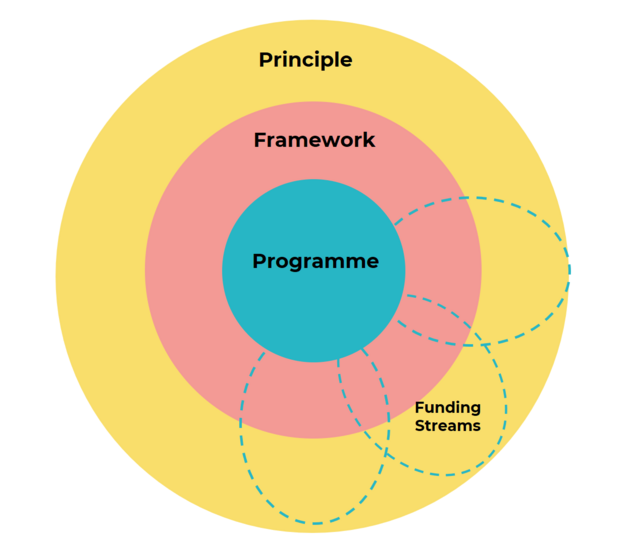The Place Based Framework
Introduction
Place is already at the forefront of policy. It plays a key role in government priorities, in infrastructure investment, climate action, and planning policies. These agendas now need to be reflected on the ground in the circumstances of people’s lives. Not only tackling the issues of today but helping to put in place the steps which will prevent tomorrow’s problems and enable better futures.
The purpose of the Place Based Framework is to build on existing good work across Scotland and provide a mechanism for how place-based working can be implemented effectively.
Taking a place based approach involves dealing with complexity. It recognises that to achieve real change demands tackling more than one thing at a time. A consistent approach is needed and this is what the framework is designed to provide.
Structure
The Place Based Framework is a practical mechanism for linking the high-level aims of the Place Principle with the capacity of funding and delivery vehicles, such as the Place Based Investment Programme.
It is designed to be used to inform and coordinate decisions at national level, regional and local levels, supporting decision makers to shape better places across Scotland.

Context
Place is significant in our lives. It shapes who we are, frames what we become, and nurtures our aspirations. It is where we find the people and communities that are important to our sense of self. Having a real say in what happens to our place empowers who we are and who we can be.
Place is also acknowledged as a key driver of our fundamental wellbeing. And the response on the ground to the Covid-19 pandemic has highlighted the importance of local community resilience and the potential of local communities to come together and act effectively.
There is increasing recognition of the importance of 20 minute neighbourhoods, towns centres, community wealth building, and community led regeneration- all important elements of a place-based approach.
Making change happen at scale can be complicated and difficult. Looking at change in the context of a real place, its communities and partners, provides a more manageable and meaningful context to engage with competing stories.
So, place is not only vitally important, it is also a useful and relatable way to understand and implement complex change – a bridge between national policies and local action. Place based approaches simply provide a practical mechanism to ensure that
- changes made in a place are relevant to that place;
- change benefits all the people in a place
The objective is for collaboration to be an everyday reality in Scotland’s towns, villages, and neighbourhoods. For each place to be successful in its own way, with local resources targeted at the most relevant outcomes with the most meaningful impact.
This is an expression of empowerment in action. It engages with lived experiences and local opportunities. And it helps develop a shared purpose and a will to act. Pulling together scattered resources for shared outcomes, and helping collective leadership and anchor collaborations grow in the heart of communities.
The language of our ambitions is often expressed in terms of the hopes and consequences for individuals, communities, organisations, policy themes, statistics, and outcomes. And these remain the fundamental building blocks of change. However, delivering ambitions across this complex landscape, also requires the organisational scaffolding needed for practical decision-making.
Currently, investment in places can be fragmented and uncoordinated, leading to fewer benefits for the people who live there. Appraisals are not always adequate and do not always address the bigger picture. This needs to change. A common framework for considering place based investment will look at these investments in the round and help to increase the scale and pace of change in each place.

Approach
The place based approach is being implemented through three means:
- Place Principle: Adopted by Scottish Government and COSLA, this commits to a ‘more joined-up, collaborative, and participative approach to services, land and buildings, across all sectors within a place . . . ‘
- Place Based Framework: With the adoption of the Place Principle, all major spending programmes should now be taking a place based collaborative approach. These should also reflect the Scottish Government’s priorities on making the best use of current assets. To ensure alignment between these programmes a consistent place based framework is proposed for all capital spending programmes, across funding streams.
- Place Based Investment Programme: A coordinated programme of place based investments from targeted policy areas. In practice this will mean that each investment will:
- Consider at a national level how this investment aligns with other planned investments in that locality, to streamline delivery and increase impact.
- Address the core questions set out in the Place Based Framework to ensure that the investment is relevant to the needs of the locality, fits with other local actions, and provides the basis for collaboration with partners.
- Help establish a local programme board which provides local oversight and a focus for community participation and collective leadership.
The Framework proposes that before investing in a place it is first necessary to have established a common narrative, a shared action plan and a meaningful oversight structure. The Framework therefore asks decision makers to consider a series of basic questions designed to understand the fundamental nature of a place, the reasons why it needs to change, what its future should be, how separate activities will dovetail into an overall programme for change, and how collective leadership will be realised and sustained.
Most places have already been the subject of a variety of different exercises designed to derive local plans. A lot of information already exists. And there are already a number of different organisations, tools and techniques to support this kind of work. Which ones are best for any one place will depend on its own context.
This Framework seeks to provide a common proportionate basis for conditionality across local funding programmes built around three key outputs:
-
Place Narrative
-
Place Actions
-
Place Oversight
Find out more about these key outputs using the below links.
Summary
Life in a place can be changed by the way in which small but significant interventions come together. Communities can be transformed when investments are brought together and shaped by a real understanding of the places they live.
The Place Based Framework is designed to help make the Place Principle a reality in everyday lives and to set out a baseline for how we consider the importance of local in how we make decisions. It provides a challenge to the assumptions we make about places without their participation. And it does this by demanding answers to straightforward questions before we decide what to do, and what to stop doing.
Core Questions
Narrative
- Why is change needed?
- Where do things need to change?
- What changes will make a difference?
Actions
- What are our objectives?
- How are we going to do this?
- How do we organise ourselves?
Oversight
- What are our shared principles?
- How will we provide assurance?
- What are our priorities for change?
- How will we gain approvals?
- How do we assess our impact?
In summary the ambition is to nurture places across Scotland where authentic narratives form the basis for more coordinated programmes of actions with more collaborative oversight. The impact on people’s lives will be to shape changes that are relevant to the places they live in and that benefit all the people in those places.